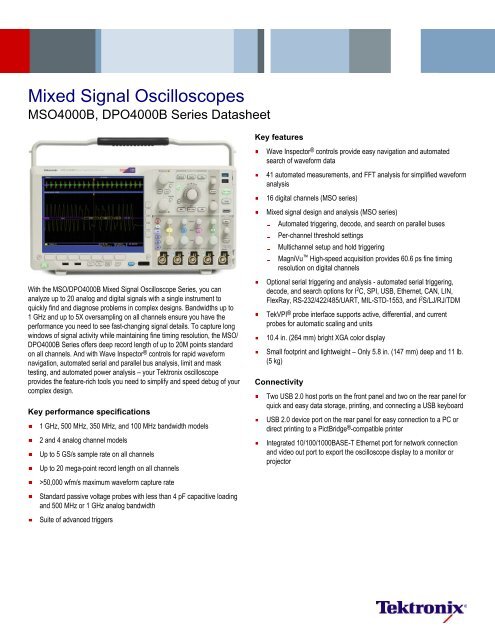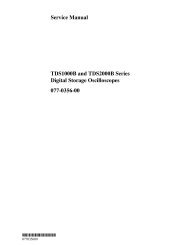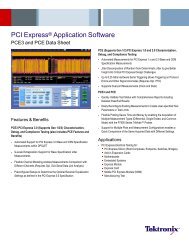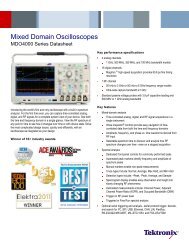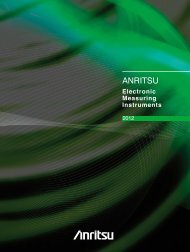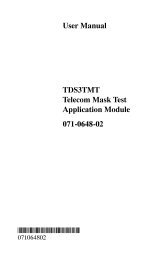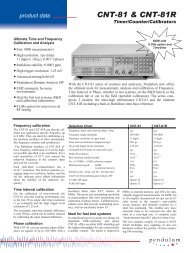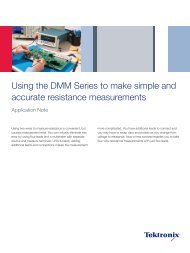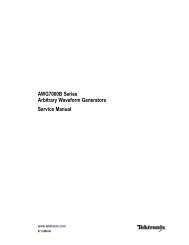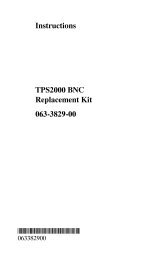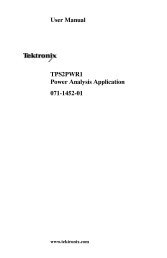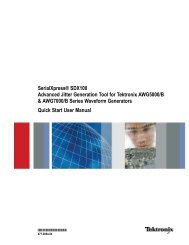Osciloscopios Tektronix de las series DPO4000B y ... - AFC Ingenieros
Osciloscopios Tektronix de las series DPO4000B y ... - AFC Ingenieros
Osciloscopios Tektronix de las series DPO4000B y ... - AFC Ingenieros
You also want an ePaper? Increase the reach of your titles
YUMPU automatically turns print PDFs into web optimized ePapers that Google loves.
Mixed Signal Oscilloscopes<br />
MSO4000B, <strong>DPO4000B</strong> Series Datasheet<br />
Key features<br />
Wave Inspector ® controls provi<strong>de</strong> easy navigation and automated<br />
search of waveform data<br />
41 automated measurements, and FFT analysis for simplified waveform<br />
analysis<br />
16 digital channels (MSO <strong>series</strong>)<br />
With the MSO/<strong>DPO4000B</strong> Mixed Signal Oscilloscope Series, you can<br />
analyze up to 20 analog and digital signals with a single instrument to<br />
quickly find and diagnose problems in complex <strong>de</strong>signs. Bandwidths up to<br />
1 GHz and up to 5X oversampling on all channels ensure you have the<br />
performance you need to see fast-changing signal <strong>de</strong>tails. To capture long<br />
windows of signal activity while maintaining fine timing resolution, the MSO/<br />
<strong>DPO4000B</strong> Series offers <strong>de</strong>ep record length of up to 20M points standard<br />
on all channels. And with Wave Inspector ® controls for rapid waveform<br />
navigation, automated serial and parallel bus analysis, limit and mask<br />
testing, and automated power analysis – your <strong>Tektronix</strong> oscilloscope<br />
provi<strong>de</strong>s the feature-rich tools you need to simplify and speed <strong>de</strong>bug of your<br />
complex <strong>de</strong>sign.<br />
Key performance specifications<br />
1 GHz, 500 MHz, 350 MHz, and 100 MHz bandwidth mo<strong>de</strong>ls<br />
2 and 4 analog channel mo<strong>de</strong>ls<br />
Up to 5 GS/s sample rate on all channels<br />
Up to 20 mega-point record length on all channels<br />
>50,000 wfm/s maximum waveform capture rate<br />
Standard passive voltage probes with less than 4 pF capacitive loading<br />
and 500 MHz or 1 GHz analog bandwidth<br />
Suite of advanced triggers<br />
Mixed signal <strong>de</strong>sign and analysis (MSO <strong>series</strong>)<br />
Automated triggering, <strong>de</strong>co<strong>de</strong>, and search on parallel buses<br />
Per-channel threshold settings<br />
Multichannel setup and hold triggering<br />
MagniVu High-speed acquisition provi<strong>de</strong>s 60.6 ps fine timing<br />
resolution on digital channels<br />
Optional serial triggering and analysis - automated serial triggering,<br />
<strong>de</strong>co<strong>de</strong>, and search options for I 2 C, SPI, USB, Ethernet, CAN, LIN,<br />
FlexRay, RS-232/422/485/UART, MIL-STD-1553, and I 2 S/LJ/RJ/TDM<br />
TekVPI ® probe interface supports active, differential, and current<br />
probes for automatic scaling and units<br />
10.4 in. (264 mm) bright XGA color display<br />
Small footprint and lightweight – Only 5.8 in. (147 mm) <strong>de</strong>ep and 11 lb.<br />
(5 kg)<br />
Connectivity<br />
Two USB 2.0 host ports on the front panel and two on the rear panel for<br />
quick and easy data storage, printing, and connecting a USB keyboard<br />
USB 2.0 <strong>de</strong>vice port on the rear panel for easy connection to a PC or<br />
direct printing to a PictBridge ® -compatible printer<br />
Integrated 10/100/1000BASE-T Ethernet port for network connection<br />
and vi<strong>de</strong>o out port to export the oscilloscope display to a monitor or<br />
projector
Datasheet<br />
Optional application support<br />
Power analysis<br />
Limit and mask testing<br />
HDTV and custom vi<strong>de</strong>o analysis<br />
Comprehensive features speed every stage of<br />
<strong>de</strong>bug<br />
These oscilloscopes offer a robust set of features to speed every stage of<br />
<strong>de</strong>bugging your <strong>de</strong>sign – from quickly discovering an anomaly and<br />
capturing it, to searching your waveform record for the event and analyzing<br />
its characteristics and your <strong>de</strong>vice’s behavior.<br />
Discover<br />
To <strong>de</strong>bug a <strong>de</strong>sign problem, first you must know it exists. Every <strong>de</strong>sign<br />
engineer spends time looking for problems in their <strong>de</strong>sign, a timeconsuming<br />
and frustrating task without the right <strong>de</strong>bug tools.<br />
The industry’s most complete visualization of signals provi<strong>de</strong>s fast insight<br />
into the real operation of your <strong>de</strong>vice. A fast waveform capture rate –<br />
greater than 50,000 waveforms per second – enables you to see glitches<br />
and other infrequent transients within seconds, revealing the true nature of<br />
<strong>de</strong>vice faults. A digital phosphor display with intensity grading shows the<br />
history of a signal’s activity by intensifying areas of the signal that occur<br />
more frequently, providing a visual display of just how often anomalies<br />
occur.<br />
Capture<br />
Discovering a <strong>de</strong>vice fault is only the first step. Next, you must capture the<br />
event of interest to i<strong>de</strong>ntify root cause.<br />
Accurately capturing any signal of interest begins with proper probing. Lowcapacitance<br />
probes are inclu<strong>de</strong>d with the oscilloscope, one for each analog<br />
channel. These industry-first high-impedance passive voltage probes have<br />
less than 4 pF of capacitive loading to minimize the affect of the probe on<br />
your circuit's operation, offering the performance of an active probe with the<br />
flexibility of a passive probe.<br />
A complete set of triggers - including runt, timeout, logic, pulse width/glitch,<br />
setup/hold violation, serial packet, and parallel data - help you quickly find<br />
your event. With up to a 20M point record length, you can capture many<br />
events of interest, even thousands of serial packets, in a single acquisition<br />
for further analysis while maintaining high resolution to zoom in on fine<br />
signal <strong>de</strong>tails.<br />
From triggering on specific packet content to automatic <strong>de</strong>co<strong>de</strong> in multiple<br />
data formats, the oscilloscope provi<strong>de</strong>s integrated support for the industry's<br />
broa<strong>de</strong>st range of serial buses - I 2 C, SPI, USB, Ethernet, CAN, LIN,<br />
FlexRay, RS-232/422/485/UART, MIL-STD-1553, and I 2 S/LJ/RJ/TDM. The<br />
ability to <strong>de</strong>co<strong>de</strong> up to four serial and/or parallel buses simultaneously<br />
means you gain insight into system-level problems quickly.<br />
To further help troubleshoot system-level interactions in complex embed<strong>de</strong>d<br />
systems, the oscilloscope offers 16 digital channels in addition to its analog<br />
channels. Since the digital channels are fully integrated into the<br />
oscilloscope, you can trigger across all input channels, automatically time<br />
correlating all analog, digital, and serial signals. The MagniVu high-speed<br />
acquisition on these channels enables you to acquire fine signal <strong>de</strong>tail (up<br />
to 60.6 ps resolution) around the trigger point for precision timing<br />
measurements. MagniVu is essential for making accurate timing<br />
measurements for setup and hold, clock <strong>de</strong>lay, signal skew, and glitch<br />
characterization.<br />
Discover ‒ Fast waveform capture rate - over 50,000 wfm/s - maximizes the probability<br />
of capturing elusive glitches and other infrequent events.<br />
Capture - Triggering on a specific transmit data packet going across an RS-232 bus. A<br />
complete set of triggers, including triggers for specific serial packet content, ensures you<br />
quickly capture your event of interest.<br />
2 www.tektronix.com
Mixed Signal Oscilloscopes — MSO4000B, <strong>DPO4000B</strong> Series<br />
Search<br />
Finding your event of interest in a long waveform record can be time<br />
consuming without the right search tools. With today’s record lengths<br />
pushing beyond a million data points, locating your event can mean<br />
scrolling through thousands of screens of signal activity.<br />
The innovative Wave Inspector ® controls give you the industry’s most<br />
comprehensive search and waveform navigation capability. These controls<br />
speed panning and zooming through your record. With a unique forcefeedback<br />
system, you can move from one end of your record to the other in<br />
just seconds. User marks allow you to mark any location that you may want<br />
to reference later for further investigation. Or, automatically search your<br />
record for criteria you <strong>de</strong>fine. Wave Inspector will instantly search your<br />
entire record, including analog, digital, and serial bus data. Along the way it<br />
will automatically mark every occurrence of your <strong>de</strong>fined event so you can<br />
quickly move between events.<br />
Analyze – Waveform histogram of a falling edge showing the distribution of edge position<br />
(jitter) over time. Inclu<strong>de</strong>d are numeric measurements ma<strong>de</strong> on the waveform histogram<br />
data. A comprehensive set of integrated analysis tools speeds verification of your<br />
<strong>de</strong>sign's performance.<br />
Mixed domain analysis<br />
Working with RF signals? Be sure to check out the MDO4000 Series - the<br />
world's first Mixed Domain Oscilloscope. Built on the MSO4000B<br />
oscilloscope platform, the MDO4000 Series offers a built-in spectrum<br />
analyzer (up to 6 GHz). This combination offers you the ability to capture<br />
time-correlated analog, digital, and RF signals in a single instrument. For<br />
more information on the MDO4000 Series, please visit www.tektronix.com/<br />
mdo4000.<br />
Search ‒ I 2 C <strong>de</strong>co<strong>de</strong> showing results from a Wave Inspector search for Address value<br />
50. Wave Inspector controls provi<strong>de</strong> unprece<strong>de</strong>nted efficiency in viewing and navigating<br />
waveform data.<br />
Analyze<br />
Verifying that your prototype’s performance matches simulations and meets<br />
the project’s <strong>de</strong>sign goals requires analyzing its behavior. Tasks can range<br />
from simple checks of rise times and pulse widths to sophisticated power<br />
loss analysis and investigation of noise sources.<br />
The oscilloscope offers a comprehensive set of integrated analysis tools<br />
including waveform- and screen-based cursors, automated measurements,<br />
advanced waveform math including arbitrary equation editing, FFT analysis,<br />
and trend plots for visually <strong>de</strong>termining how a measurement is changing<br />
over time. Specialized application support for serial bus analysis, power<br />
supply <strong>de</strong>sign, and vi<strong>de</strong>o <strong>de</strong>sign and <strong>de</strong>velopment is also available.<br />
For exten<strong>de</strong>d analysis, National Instrument’s LabVIEW SignalExpress ®<br />
<strong>Tektronix</strong> Edition provi<strong>de</strong>s over 200 built-in functions including time and<br />
frequency domain analysis, limit testing, data logging, and customizable<br />
reports.<br />
Wave Inspector ® navigation and search<br />
With up to 20M record lengths, a single acquisition can inclu<strong>de</strong> thousands<br />
of screens of waveform data. Wave Inspector ® , the industry’s best tool for<br />
navigation and search, enables you to find events of interest in seconds.<br />
Wave Inspector controls provi<strong>de</strong> unprece<strong>de</strong>nted efficiency in viewing, navigating, and<br />
analyzing waveform data. Zip through your long record by turning the outer pan control<br />
(1). Get <strong>de</strong>tails from the beginning to end in seconds. See something of interest and want<br />
to see more <strong>de</strong>tails? Just turn the inner zoom control (2).<br />
www.tektronix.com 3
Datasheet<br />
Zoom and pan<br />
A <strong>de</strong>dicated, two-tier front-panel control provi<strong>de</strong>s intuitive control of both<br />
zooming and panning. The inner control adjusts the zoom factor (or zoom<br />
scale); turning it clockwise activates zoom and goes to progressively higher<br />
zoom factors, while turning it counterclockwise results in lower zoom factors<br />
and eventually turning zoom off. No longer do you need to navigate through<br />
multiple menus to adjust your zoom view. The outer control pans the zoom<br />
box across the waveform to quickly get to the portion of waveform you are<br />
interested in. The outer control also utilizes force-feedback to <strong>de</strong>termine<br />
how fast to pan on the waveform. The farther you turn the outer control, the<br />
faster the zoom box moves. Pan direction is changed by simply turning the<br />
control the other way.<br />
Play/Pause<br />
A <strong>de</strong>dicated Play/Pause front-panel button scrolls the waveform across the<br />
display automatically while you look for anomalies or an event of interest.<br />
Playback speed and direction are controlled using the intuitive pan control.<br />
Once again, turning the control further makes the waveform scroll faster and<br />
changing direction is as simple as turning the control the other way.<br />
User marks<br />
Press the Set Mark front-panel button to place one or more marks on the<br />
waveform. Navigating between marks is as simple as pressing the<br />
Previous (←) and Next (→) buttons on the front panel.<br />
Search marks<br />
The Search button allows you to automatically search through your long<br />
acquisition looking for user-<strong>de</strong>fined events. All occurrences of the event are<br />
highlighted with search marks and are easily navigated to, using the frontpanel<br />
Previous (←) and Next (→) buttons. Search types inclu<strong>de</strong> edge,<br />
pulse width/glitch, timeout, runt, logic, setup and hold, rise/fall time, parallel<br />
bus, and I 2 C, SPI, USB, Ethernet, CAN, LIN, FlexRay, RS-232/422/485/<br />
UART, MIL-STD-1553, and I 2 S/LJ/RJ/TDM packet content.<br />
Search step 2: Wave Inspector automatically searches through the record and marks<br />
each event with a hollow white triangle. You can then use the Previous and Next buttons<br />
to jump from one event to the next.<br />
Digital phosphor technology<br />
Digital phosphor technology provi<strong>de</strong>s you with fast insight into the real<br />
operation of your <strong>de</strong>vice. Its fast waveform capture rate – greater than<br />
50,000 wfm/s – gives you a high probability of quickly seeing the infrequent<br />
problems common in digital systems: runt pulses, glitches, timing issues,<br />
and more.<br />
Waveforms are superimposed with one another and waveform points that<br />
occur more frequently are intensified. This quickly highlights the events that<br />
over time occur more often or, in the case of infrequent anomalies, occur<br />
less often.<br />
You can choose infinite persistence or variable persistence, <strong>de</strong>termining<br />
how long the previous waveform acquisitions stay on-screen. This allows<br />
you to <strong>de</strong>termine how often an anomaly is occurring.<br />
Search step 1: You <strong>de</strong>fine what you would like to find.<br />
Digital phosphor technology enables greater than 50,000 wfms/s waveform capture rate<br />
and real-time intensity grading.<br />
4 www.tektronix.com
Mixed Signal Oscilloscopes — MSO4000B, <strong>DPO4000B</strong> Series<br />
Accurate high-speed probing<br />
The TPP Series probes, inclu<strong>de</strong>d standard with every MSO/<strong>DPO4000B</strong><br />
Series oscilloscope, provi<strong>de</strong> up to 1 GHz of analog bandwidth, and less<br />
than 4 pF of capacitive loading. The extremely low capacitive loading<br />
minimizes adverse affects on your circuits and is more forgiving of longer<br />
ground leads. And, since the probe bandwidth matches or exceeds your<br />
oscilloscope bandwidth, you can see the high-frequency components in<br />
your signal which is critical for high-speed applications. The TPP Series<br />
passive voltage probes offer all the benefits of general-purpose probes like<br />
high dynamic range, flexible connection options, and robust mechanical<br />
<strong>de</strong>sign, while providing the performance of active probes. In addition, a lowattenuation,<br />
2X version of the TPP probes is available for measuring low<br />
voltages. Unlike other low-attenuation passive probes, the TPP0502 has<br />
high bandwidth (500 MHz) as well as low capacitive loading (12.7 pF).<br />
Mixed signal <strong>de</strong>sign and analysis (MSO<br />
<strong>series</strong>)<br />
The MSO mo<strong>de</strong>ls provi<strong>de</strong> 16 digital channels that are tightly integrated into<br />
the oscilloscope's user interface. This simplifies operation and makes it<br />
possible to solve mixed-signal issues easily.<br />
on the next acquisition will reveal higher frequency information than the<br />
previous settings could acquire.<br />
White edges indicate additional information is available by zooming in. As shown here,<br />
zooming in on the white edge reveals a hid<strong>de</strong>n glitch.<br />
You can group digital waveforms and enter waveform labels by using a USB<br />
keyboard. By simply placing digital waveforms next to each other, they form<br />
a group.<br />
The MSO Series provi<strong>de</strong>s 16 integrated digital channels enabling you to view and<br />
analyze time-correlated analog and digital signals.<br />
Color-co<strong>de</strong>d digital waveform display<br />
This oscilloscope has re<strong>de</strong>fined the way you view digital waveforms. One<br />
common problem shared by both logic analyzers and mixed-signal<br />
oscilloscopes is <strong>de</strong>termining if data is a one or a zero when zoomed in far<br />
enough that the digital trace stays flat all the way across the display. Colorco<strong>de</strong>d<br />
digital traces display ones in green and zeros in blue.<br />
The multiple transition <strong>de</strong>tection hardware shows you a white edge on the<br />
display when the system <strong>de</strong>tects multiple transitions. White edges indicate<br />
that more information is available by zooming in or acquiring at faster<br />
sampling rates. In most cases zooming in will reveal the pulse that was not<br />
viewable with the previous settings. If the white edge is still present after<br />
zooming in as far as possible, this indicates that increasing the sample rate<br />
With color-co<strong>de</strong>d digital waveform display, groups are created by simply placing digital<br />
channels together on the screen, allowing digital channels to be moved as a group. You<br />
can set threshold values for each channel, enabling support for up to 16 different logic<br />
families.<br />
Once a group is formed, you can position all the channels contained in that<br />
group collectively. This greatly reduces the normal setup time associated<br />
with positioning channels individually.<br />
www.tektronix.com 5
Datasheet<br />
MagniVu ® high-speed acquisition<br />
The main digital acquisition mo<strong>de</strong> on the MSO4000B Series will capture up<br />
to 20M points at 500 MS/s (2 ns resolution). In addition to the main record,<br />
the oscilloscope provi<strong>de</strong>s an ultra high-resolution record called MagniVu<br />
which acquires 10,000 points at up to 16.5 GS/s (60.6 ps resolution). Both<br />
main and MagniVu waveforms are acquired on every trigger and can be<br />
switched between in the display at any time, running or stopped. MagniVu<br />
provi<strong>de</strong>s significantly finer timing resolution than comparable MSOs on the<br />
market, instilling confi<strong>de</strong>nce when making critical timing measurements on<br />
digital waveforms.<br />
The P6616 MSO probe offers two eight-channel pods to simplify connecting to your<br />
<strong>de</strong>vice.<br />
The MagniVu high-resolution record provi<strong>de</strong>s 60.6 ps timing resolution, enabling you to<br />
make critical timing measurements on your digital waveforms.<br />
P6616 MSO probe<br />
This unique probe <strong>de</strong>sign offers two eight-channel pods. Each channel ends<br />
with a probe tip featuring a recessed ground for simplified connection to the<br />
<strong>de</strong>vice un<strong>de</strong>r test. The coax on the first channel of each pod is colored blue<br />
making it easy to i<strong>de</strong>ntify. The common ground uses an automotive-style<br />
connector making it easy to create custom grounds for connecting to the<br />
<strong>de</strong>vice un<strong>de</strong>r test. When connecting to square pins, the P6616 has an<br />
adapter that attaches to the probe head extending the probe ground flush<br />
with the probe tip so you can attach to a hea<strong>de</strong>r. The P6616 offers<br />
outstanding electrical characteristics, having only 3 pF of capacitive loading,<br />
a 100 kΩ input resistance, and is capable of acquiring toggle rates<br />
>500 MHz and pulses as short as 1 ns in duration.<br />
Serial triggering and analysis (optional)<br />
On a serial bus, a single signal often inclu<strong>de</strong>s address, control, data, and<br />
clock information. This can make isolating events of interest difficult.<br />
Automatic trigger, <strong>de</strong>co<strong>de</strong>, and search on bus events and conditions gives<br />
you a robust set of tools for <strong>de</strong>bugging serial buses.<br />
Triggering on a specific OUT Token packet on a USB full-speed serial bus. The yellow<br />
waveform is the D+ and the blue waveform is the D-. A bus waveform provi<strong>de</strong>s <strong>de</strong>co<strong>de</strong>d<br />
packet content including Start, Sync, PID, Address, End Point, CRC, Data values, and<br />
Stop.<br />
6 www.tektronix.com
Mixed Signal Oscilloscopes — MSO4000B, <strong>DPO4000B</strong> Series<br />
Serial triggering<br />
Trigger on packet content such as start of packet, specific addresses,<br />
specific data content, unique i<strong>de</strong>ntifiers, etc. on popular serial interfaces<br />
such as I 2 C, SPI, USB, Ethernet, CAN, LIN, FlexRay, RS-232/422/485/<br />
UART, MIL-STD-1553, and I 2 S/LJ/RJ/TDM.<br />
Bus display<br />
Provi<strong>de</strong>s a higher-level, combined view of the individual signals (clock, data,<br />
chip enable, etc.) that make up your bus, making it easy to i<strong>de</strong>ntify where<br />
packets begin and end and i<strong>de</strong>ntifying sub-packet components such as<br />
address, data, i<strong>de</strong>ntifier, CRC, etc.<br />
Bus <strong>de</strong>coding<br />
Tired of having to visually inspect the waveform to count clocks, <strong>de</strong>termine if<br />
each bit is a 1 or a 0, combine bits into bytes, and <strong>de</strong>termine the hex value?<br />
Let the oscilloscope do it for you! Once you've set up a bus, the MSO/<br />
<strong>DPO4000B</strong> Series will <strong>de</strong>co<strong>de</strong> each packet on the bus, and display the<br />
value in hex, binary, <strong>de</strong>cimal (USB, Ethernet, MIL-STD-1553, LIN, and<br />
FlexRay only), signed <strong>de</strong>cimal (I 2 S/LJ/RJ/TDM only), or ASCII (USB,<br />
Ethernet, and RS-232/422/485/UART only) in the bus waveform.<br />
Event table<br />
In addition to seeing <strong>de</strong>co<strong>de</strong>d packet data on the bus waveform itself, you<br />
can view all captured packets in a tabular view much like you would see in a<br />
software listing. Packets are time stamped and listed consecutively with<br />
columns for each component (Address, Data, etc.). You can save the event<br />
table data in .csv format.<br />
Search (serial triggering)<br />
Serial triggering is very useful for isolating the event of interest, but once<br />
you’ve captured it and need to analyze the surrounding data, what do you<br />
do? In the past, users had to manually scroll through the waveform counting<br />
and converting bits and looking for what caused the event. You can have<br />
the oscilloscope automatically search through the acquired data for user<strong>de</strong>fined<br />
criteria including serial packet content. Each occurrence is<br />
highlighted by a search mark. Rapid navigation between marks is as simple<br />
as pressing the Previous (←) and Next (→) buttons on the front panel.<br />
Power analysis (optional)<br />
Ever increasing consumer <strong>de</strong>mand for longer battery-life <strong>de</strong>vices and for<br />
green solutions that consume less power require power-supply <strong>de</strong>signers to<br />
characterize and minimize switching losses to improve efficiency. In<br />
addition, the supply’s power levels, output purity, and harmonic feedback<br />
into the power line must be characterized to comply with national and<br />
regional power quality standards. Historically, making these and many other<br />
power measurements on an oscilloscope has been a long, manual, and<br />
tedious process. The optional power analysis tools greatly simplify these<br />
tasks, enabling quick and accurate analysis of power quality, switching loss,<br />
harmonics, safe operating area (SOA), modulation, ripple, and slew rate (di/<br />
dt, dv/dt). Completely integrated into the oscilloscope, the power analysis<br />
tools provi<strong>de</strong> automated, repeatable power measurements with a touch of a<br />
button; no external PC or complex software setup is required.<br />
Safe operating area measurement. Automated power measurements enable quick and<br />
accurate analysis of common power parameters.<br />
Event table showing <strong>de</strong>co<strong>de</strong>d i<strong>de</strong>ntifier, DLC, DATA, and CRC for every CAN packet in a<br />
long acquisition.<br />
www.tektronix.com 7
Datasheet<br />
Limit/Mask testing<br />
A common task during the <strong>de</strong>velopment process is characterizing the<br />
behavior of certain signals in a system. One method, called limit testing, is<br />
to compare a tested signal to a known good or "gol<strong>de</strong>n" version of the same<br />
signal with user-<strong>de</strong>fined vertical and horizontal tolerances. Another common<br />
method, called mask testing, is to compare a tested signal to a mask,<br />
looking for where a signal un<strong>de</strong>r test violates the mask. The MSO/<br />
<strong>DPO4000B</strong> Series offers both limit and mask testing capability useful for<br />
long-term signal monitoring, characterizing signals during <strong>de</strong>sign, or testing<br />
on a production line. A robust set of telecommunications and computer<br />
standards are provi<strong>de</strong>d to test for compliance to a standard. Additionally,<br />
custom masks can be created and used for characterizing signals. Tailor a<br />
test to your specific requirements by <strong>de</strong>fining test duration in number of<br />
waveforms or time, a violation threshold that must be met before<br />
consi<strong>de</strong>ring a test a failure, counting hits along with statistical information,<br />
and actions upon violations, test failure, and test complete. Whether<br />
specifying a mask from a known good signal or from a custom or standard<br />
mask, conducting pass/fail tests in search of waveform anomalies such as<br />
glitches has never been easier.<br />
Vi<strong>de</strong>o <strong>de</strong>sign and <strong>de</strong>velopment<br />
Many vi<strong>de</strong>o engineers have remained loyal to analog oscilloscopes,<br />
believing the intensity gradations on an analog display are the only way to<br />
see certain vi<strong>de</strong>o waveform <strong>de</strong>tails. The fast waveform capture rate,<br />
coupled with its intensity-gra<strong>de</strong>d view of the signal, provi<strong>de</strong>s the same<br />
information-rich display as an analog oscilloscope, but with much more<br />
<strong>de</strong>tail and all the benefits of digital scopes.<br />
Standard features such as IRE and mV graticules, holdoff by fields, vi<strong>de</strong>o<br />
polarity, and an Autoset smart enough to <strong>de</strong>tect vi<strong>de</strong>o signals, make these<br />
the easiest to use oscilloscopes on the market for vi<strong>de</strong>o applications. And<br />
with high bandwidth and four analog inputs, the oscilloscope provi<strong>de</strong>s<br />
ample performance for analog and digital vi<strong>de</strong>o use.<br />
The vi<strong>de</strong>o functionality is further exten<strong>de</strong>d with an optional vi<strong>de</strong>o application<br />
module, which provi<strong>de</strong>s the industry's most complete suite of HDTV and<br />
custom (nonstandard) vi<strong>de</strong>o triggers.<br />
Designed to make your work easier<br />
The MSO/<strong>DPO4000B</strong> Series is <strong>de</strong>signed to make your work easier. The large, highresolution<br />
display shows intricate signal <strong>de</strong>tails. Dedicated front-panel controls simplify<br />
operation. Two USB host ports on the front panel allow you to easily transfer screen<br />
shots, instrument settings, and waveform data to a USB mass storage <strong>de</strong>vice.<br />
Limit Test showing a mask created from a gol<strong>de</strong>n waveform and compared against a live<br />
signal. Results showing statistical information about the test are displayed.<br />
Large, high-resolution display<br />
The MSO/<strong>DPO4000B</strong> Series features a 10.4 in. (264 mm) bright, LED<br />
backlit XGA color display for seeing intricate signal <strong>de</strong>tails.<br />
Dedicated front-panel controls<br />
Per-channel vertical controls provi<strong>de</strong> simple and intuitive operation. No<br />
longer do you need to share one set of vertical controls across all four<br />
channels.<br />
8 www.tektronix.com
Mixed Signal Oscilloscopes — MSO4000B, <strong>DPO4000B</strong> Series<br />
Connectivity<br />
Two USB host ports on the front panel enable easy transfer of screenshots,<br />
instrument settings, and waveform data to a USB mass storage <strong>de</strong>vice. The<br />
rear panel contains two additional USB host ports and a USB <strong>de</strong>vice port for<br />
controlling the oscilloscope remotely from a PC or for connecting a USB<br />
keyboard. The USB <strong>de</strong>vice port can also be used to print directly to a<br />
PictBridge ® -compatible printer. An integrated 10/100/1000BASE-T Ethernet<br />
port enables easy connection to networks and a Vi<strong>de</strong>o Out port allows the<br />
oscilloscope display to be exported to an external monitor or projector. The<br />
instrument can mount external network drives for easy storage of screen<br />
images, setup files, or data files. Setup or data files can then be directly<br />
recalled and loa<strong>de</strong>d into the oscilloscope from the network drive location.<br />
The MSO/<strong>DPO4000B</strong> Series is LXI C<strong>las</strong>s-C compliant.<br />
Compact form factor<br />
With the compact, portable form factor, you can easily move the<br />
oscilloscope between labs. And with a <strong>de</strong>pth of just 5.8 inches (147 mm), it<br />
saves you valuable space on your test bench.<br />
The MSO/DPO 4000B Series compact form factor frees up valuable space on your<br />
bench or <strong>de</strong>sktop.<br />
TekVPI probe interface simplifies connecting your probes to the oscilloscope.<br />
Exten<strong>de</strong>d analysis<br />
Exporting data and measurements is as simple as connecting a USB cable<br />
from the oscilloscope to your PC. Key software applications – NI LabVIEW<br />
SignalExpress <strong>Tektronix</strong> Edition LE, OpenChoice ® Desktop, and Microsoft<br />
Excel and Word toolbars – are inclu<strong>de</strong>d standard with each oscilloscope to<br />
enable fast and easy direct communication with your Windows PC.<br />
NI LabVIEW SignalExpress <strong>Tektronix</strong> Edition LE enables you to instantly<br />
acquire, generate, analyze, compare, import, and save measurement data<br />
and signals using an intuitive drag-and-drop user interface that does not<br />
require any programming. The optional Professional Version offers over 200<br />
built-in functions that provi<strong>de</strong> additional signal processing, advanced<br />
analysis, sweeping, limit testing and user-<strong>de</strong>fined step capabilities.<br />
For simple tasks, the inclu<strong>de</strong>d OpenChoice Desktop enables fast and easy<br />
communication between the oscilloscope and your PC through USB or LAN<br />
for transferring settings, waveforms, and screen images.<br />
TekVPI ® probe interface<br />
The TekVPI probe interface sets the standard for ease of use in probing. In<br />
addition to the secure, reliable connection that the interface provi<strong>de</strong>s,<br />
TekVPI probes feature status indicators and controls, as well as a probe<br />
menu button right on the comp box itself. This button brings up a probe<br />
menu on the oscilloscope display with all relevant settings and controls for<br />
the probe. The TekVPI interface enables direct attachment of current<br />
probes without requiring a separate power supply. TekVPI probes can be<br />
controlled remotely through USB, GPIB, or LAN, enabling more versatile<br />
solutions in ATE environments.<br />
OpenChoice Desktop software enables seamless connection between the oscilloscope<br />
and your PC.<br />
www.tektronix.com 9
Datasheet<br />
The MSO/<strong>DPO4000B</strong> Series can also be connected to your network using<br />
the LAN port. The inclu<strong>de</strong>d LXI web interface provi<strong>de</strong>s information about the<br />
current configuration of your MSO/<strong>DPO4000B</strong> Series oscilloscope, including<br />
network configuration. The LXI web interface also provi<strong>de</strong>s remote<br />
instrument control through the popular e*Scope web-based instrument<br />
control capability. You can make changes to the network configuration,<br />
control instrument settings, save screen images and instrument data, and<br />
save/load instrument setups of your oscilloscope directly from the web<br />
interface through a password-protected web page.<br />
The LXI web interface provi<strong>de</strong>s access to network settings, enables remote instrument<br />
control and is accessible from any standard web browser.<br />
10 www.tektronix.com
Mixed Signal Oscilloscopes — MSO4000B, <strong>DPO4000B</strong> Series<br />
Specifications<br />
All specifications apply to all mo<strong>de</strong>ls unless noted otherwise.<br />
Mo<strong>de</strong>l overview<br />
DPO4014B,<br />
MSO4014B<br />
DPO4034B,<br />
MSO4034B<br />
DPO4054B,<br />
MSO4054B<br />
DPO4102B-L,<br />
MSO4102B-L<br />
DPO4102B,<br />
MSO4102B<br />
DPO4104B-L,<br />
MSO4104B-L<br />
Analog channels 4 4 4 2 2 4 4<br />
Bandwidth 100 MHz 350 MHz 500 MHz 1 GHz 1 GHz 1 GHz 1 GHz<br />
Rise time 3.5 ns 1 ns 700 ps 350 ps 350 ps 350 ps 350 ps<br />
Sample rate (1 ch) 2.5 GS/s 2.5 GS/s 2.5 GS/s 5 GS/s 5 GS/s 5 GS/s 5 GS/s<br />
Sample rate (2 ch) 2.5 GS/s 2.5 GS/s 2.5 GS/s 2.5 GS/s 5 GS/s 5 GS/s 5 GS/s<br />
Sample rate (4 ch) 2.5 GS/s 2.5 GS/s 2.5 GS/s -- -- 2.5 GS/s 5 GS/s<br />
Record length (1 ch) 20M 20M 20M 5M 20M 5M 20M<br />
Record length (2 ch) 20M 20M 20M 5M 20M 5M 20M<br />
Record length (4 ch) 20M 20M 20M -- -- 5M 20M<br />
Duration at highest sample rate 8 ms 8 ms 8 ms 1 ms 4 ms 1 ms 4 ms<br />
Digital channels<br />
MSO mo<strong>de</strong>ls add 16 digital channels to the corresponding DPO mo<strong>de</strong>l<br />
DPO4104B,<br />
MSO4104B<br />
Vertical system analog channels<br />
Hardware bandwidth limits<br />
≥350 MHz mo<strong>de</strong>ls<br />
20 MHz or 250 MHz<br />
100 MHz mo<strong>de</strong>ls 20 MHz<br />
Input coupling<br />
AC, DC<br />
Input impedance 1 MΩ ±1%, 50 Ω ±1%<br />
Input sensitivity range<br />
1 MΩ 1 mV/div to 10 V/div<br />
50 Ω 1 mV/div to 1 V/div<br />
Vertical resolution<br />
8 bits (11 bits with Hi Res)<br />
Maximum input voltage<br />
1 MΩ 300 V RMS CAT II with peaks ≤ ±425 V<br />
50 Ω 5 V RMS with peaks ≤ ±20 V<br />
DC gain accuracy ±1.5%, <strong>de</strong>rated at 0.10%/°C above 30 °C<br />
Channel-to-channel isolation<br />
Any two channels at equal vertical scale ≥100:1 at ≤100 MHz and ≥30:1 at >100 MHz up to the rated bandwidth<br />
Offset range Volts/div setting Offset range<br />
1 MΩ input 50 Ω<br />
1 mV/div to 50 mV/div ±1 V ±1 V<br />
50.5 mV/div to 99.5 mV/div ±0.5 V ±0.5 V<br />
100 mV/div to 500 mV/div ±10 V ±10V<br />
505 mV/div to 995 mV/div ±5 V ±5 V<br />
1 V/div to 5 V/div ±100 V ±5 V<br />
5.05 V/div to 10 V/div ±50 V NA<br />
www.tektronix.com 11
Datasheet<br />
Vertical system digital channels<br />
Input channels 16 digital (D15 to D0)<br />
Thresholds<br />
Threshold selections<br />
User-<strong>de</strong>fined threshold range<br />
Threshold accuracy<br />
Maximum input voltage<br />
Input dynamic range<br />
Minimum voltage swing<br />
Probe loading<br />
Vertical resolution<br />
Per-channel thresholds<br />
TTL, CMOS, ECL, PECL, User Defined<br />
±40 V<br />
±[100 mV + 3% of threshold setting]<br />
±42 V peak<br />
30 V p-p ≤200 MHz<br />
10 V p-p >200 MHz<br />
400 mV<br />
100 kΩ in parallel with 3 pF<br />
1 bit<br />
Horizontal system analog channels<br />
Time base range<br />
1 GHz mo<strong>de</strong>ls 400 ps to 1000 s<br />
≤ 500 MHz mo<strong>de</strong>ls<br />
1 ns to 1000 s<br />
Time-base <strong>de</strong>lay time range<br />
Channel-to-channel <strong>de</strong>skew range<br />
Time base accuracy<br />
-10 divisions to 5000 s<br />
±125 ns<br />
±5 ppm over any ≥1 ms interval<br />
Horizontal system digital channels<br />
Maximum sample rate (Main)<br />
Maximum record length (Main)<br />
Maximum sample rate (MagniVu)<br />
Maximum record length (MagniVu)<br />
Minimum <strong>de</strong>tectable pulse width<br />
(typical)<br />
Channel-to-channel skew (typical)<br />
Maximum input toggle rate<br />
500 MS/s (2 ns resolution)<br />
20M points (5M points on -L mo<strong>de</strong>ls)<br />
16.5 GS/s (60.6 ps resolution)<br />
10k points centered around the trigger<br />
1 ns<br />
200 ps<br />
500 MHz (Maximum frequency sine wave that can accurately be reproduced as a logic square wave. Requires the use of a short<br />
ground exten<strong>de</strong>r on each channel. This is the maximum frequency at the minimum swing amplitu<strong>de</strong>. Higher toggle rates can be<br />
achieved with higher amplitu<strong>de</strong>s.)<br />
12 www.tektronix.com
Mixed Signal Oscilloscopes — MSO4000B, <strong>DPO4000B</strong> Series<br />
Trigger system<br />
Trigger mo<strong>de</strong>s<br />
Trigger coupling<br />
Trigger holdoff range<br />
Auto, Normal, and Single<br />
DC, AC, HF reject (attenuates >50 kHz), LF reject (attenuates ,
Datasheet<br />
USB: Low speed (optional)<br />
USB: Full speed (optional)<br />
USB: High speed (optional) 1<br />
Trigger on Sync Active, Start of Frame, Reset, Suspend, Resume, End of Packet, Token (Address) Packet, Data Packet,<br />
Handshake Packet, Special Packet, Error.<br />
Token packet trigger - Any token type, SOF, OUT, IN, SETUP; Address can be specified for Any Token, OUT, IN, and SETUP<br />
token types. Address can be further specified to trigger on ≤, , ≥, ≠ a particular value, or insi<strong>de</strong> or outsi<strong>de</strong> of a range. Frame<br />
number can be specified for SOF token using binary, hex, unsigned <strong>de</strong>cimal and don't care digits.<br />
Data packet trigger - Any data type, DATA0, DATA1; Data can be further specified to trigger on ≤, , ≥, ≠ a particular data<br />
value, or insi<strong>de</strong> or outsi<strong>de</strong> of a range.<br />
Handshake packet trigger - Any handshake type, ACK, NAK, STALL.<br />
Special packet trigger - Any special type, Reserved<br />
Error trigger - PID Check, CRC5 or CRC16, Bit Stuffing.<br />
Trigger on Sync, Reset, Suspend, Resume, End of Packet, Token (Address) Packet, Data Packet, Handshake Packet, Special<br />
Packet, Error.<br />
Token packet trigger - Any token type, SOF, OUT, IN, SETUP; Address can be specified for Any Token, OUT, IN, and SETUP<br />
token types. Address can be further specified to trigger on ≤, , ≥, ≠ a particular value, or insi<strong>de</strong> or outsi<strong>de</strong> of a range. Frame<br />
number can be specified for SOF token using binary, hex, unsigned <strong>de</strong>cimal and don't care digits.<br />
Data packet trigger - Any data type, DATA0, DATA1; Data can be further specified to trigger on ≤, , ≥, ≠ a particular data<br />
value, or insi<strong>de</strong> or outsi<strong>de</strong> of a range.<br />
Handshake packet trigger - Any handshake type, ACK, NAK, STALL.<br />
Special packet trigger - Any special type, PRE, Reserved.<br />
Error trigger - PID Check, CRC5 or CRC16, Bit Stuffing.<br />
Trigger on Sync, Reset, Suspend, Resume, End of Packet, Token (Address) Packet, Data Packet, Handshake Packet, Special<br />
Packet, Error.<br />
Token packet trigger - Any token type, SOF, OUT, IN, SETUP; Address can be specified for Any Token, OUT, IN, and SETUP<br />
token types. Address can be further specified to trigger on ≤, , ≥, ≠ a particular value, or insi<strong>de</strong> or outsi<strong>de</strong> of a range. Frame<br />
number can be specified for SOF token using binary, hex, unsigned <strong>de</strong>cimal and don't care digits.<br />
Data packet trigger - Any data type, DATA0, DATA1, DATA2, MDATA; Data can be further specified to trigger on ≤, , ≥, ≠ a<br />
particular data value, or insi<strong>de</strong> or outsi<strong>de</strong> of a range.<br />
Handshake packet trigger - Any handshake type, ACK, NAK, STALL, NYET.<br />
Special packet trigger - Any special type, ERR, SPLIT, PING, Reserved. SPLIT packet components that can be specified inclu<strong>de</strong>:<br />
▪ Hub Address<br />
▪ Start/Complete - Don't Care, Start (SSPLIT), Complete (CSPLIT)<br />
▪ Port Address<br />
▪ Start and End bits - Don't Care, Control/Bulk/Interrupt (Full-speed Device, Low-speed Device), Isochronous (Data is Middle, Data<br />
is End, Data is Start, Data is All)<br />
▪ Endpoint Type - Don't Care, Control, Isochronous, Bulk, Interrupt<br />
Error trigger - PID Check, CRC5 or CRC16.<br />
1 High-speed support only available on mo<strong>de</strong>ls with 1 GHz analog channel bandwidth.<br />
14 www.tektronix.com
Mixed Signal Oscilloscopes — MSO4000B, <strong>DPO4000B</strong> Series<br />
Ethernet (optional) 2<br />
CAN (optional)<br />
LIN (optional)<br />
FlexRay (optional)<br />
MIL-STD-1553 (optional)<br />
I 2 S/LJ/RJ/TDM (optional)<br />
Parallel (available on MSO<br />
mo<strong>de</strong>ls only)<br />
10BASE-T and 100BASE-TX: Trigger on Start Frame Delimiter, MAC Addresses, MAC Q-Tag Control Information, MAC Length/<br />
Type, IP Hea<strong>de</strong>r, TCP Hea<strong>de</strong>r, TCP/IPv4/MAC Client Data, End of Packet, and FCS (CRC) Error.<br />
100BASE-TX: Idle.<br />
MAC Addresses - Trigger on Source and Destination 48-bit address values.<br />
MAC Q-Tag Control Information - Trigger on Q-Tag 32-bit value.<br />
MAC Length/Type - Trigger on ≤, , ≥, ≠ a particular 16-bit value, or insi<strong>de</strong> or outsi<strong>de</strong> of a range.<br />
IP Hea<strong>de</strong>r - Trigger on IP Protocol 8-bit value, Source Address, Destination Address.<br />
TCP Hea<strong>de</strong>r - Trigger on Source Port, Destination Port, Sequence Number, and Ack Number.<br />
TCP/IPv4/MAC Client Data - Trigger on ≤, , ≥, ≠ a particular data value, or insi<strong>de</strong> or outsi<strong>de</strong> of a range. Selectable number of<br />
bytes to trigger on from 1-16. Byte offset options of Don't Care, 0-1499.<br />
Trigger on Start of Frame, Frame Type (data, remote, error, overload), I<strong>de</strong>ntifier (standard or exten<strong>de</strong>d), Data, I<strong>de</strong>ntifier and Data,<br />
End of Frame, Missing ACK, or Bit Stuffing Error on CAN signals up to 1 Mb/s. Data can be further specified to trigger on ≤, ,<br />
≥, or ≠ a specific data value. User-adjustable sample point is set to 50% by <strong>de</strong>fault.<br />
Trigger on Sync, I<strong>de</strong>ntifier, Data, I<strong>de</strong>ntifier and Data, Wakeup Frame, Sleep Frame, Errors such as Sync, Parity, or Checksum<br />
Errors up to 100 kb/s (by LIN <strong>de</strong>finition, 20 kb/s).<br />
Trigger on Start of Frame, Type of Frame (Normal, Payload, Null, Sync, Startup), I<strong>de</strong>ntifier, Cycle Count, Complete Hea<strong>de</strong>r Field,<br />
Data, I<strong>de</strong>ntifier and Data, End of Frame or Errors such as Hea<strong>de</strong>r CRC, Trailer CRC, Null Frame, Sync Frame, or Startup Frame<br />
Errors up to 100 Mb/s.<br />
Trigger on Sync, Word Type 3 (Command, Status, Data), Command Word (set RT Address, T/R, Sub-address/Mo<strong>de</strong>, Data Word<br />
Count/Mo<strong>de</strong> Co<strong>de</strong>, and Parity individually), Status Word (set RT Address, Message Error, Instrumentation, Service Request Bit,<br />
Broadcast Command Received, Busy, Subsystem Flag, Dynamic Bus Control Acceptance (DBCA), Terminal Flag, and Parity<br />
individually), Data Word (user-specified 16-bit data value), Error (Sync, Parity, Manchester, Non-contiguous data), Idle Time<br />
(minimum time selectable from 2 µs to 100 µs; maximum time selectable from 2 µs to 100 µs; trigger on < minimum, > maximum,<br />
insi<strong>de</strong> range, outsi<strong>de</strong> range). RT Address can be further specified to trigger on =, ≠, , ≤, ≥ a particular value, or insi<strong>de</strong> or outsi<strong>de</strong><br />
of a range.<br />
Trigger on Word Select, Frame Sync, or Data. Data can be further specified to trigger on ≤, , ≥, ≠ a specific data value, or<br />
insi<strong>de</strong> or outsi<strong>de</strong> of a range. Maximum data rate for I 2 S/LJ/RJ is 12.5 Mb/s. Maximum data rate for TDM is 25 Mb/s.<br />
Trigger on a parallel bus data value. Parallel bus can be from 1 to 16 bits (from the digital channels) plus 2 or 4 bits (from the<br />
analog channels) in size. Binary and Hex radices are supported.<br />
Acquisition system<br />
Acquisition Mo<strong>de</strong>s<br />
Sample<br />
Peak Detect<br />
Averaging<br />
Envelope<br />
Hi Res<br />
Roll<br />
Acquire sampled values.<br />
Captures glitches as narrow as 800 ps (1 GHz mo<strong>de</strong>ls) or 1.6 ns (≤500 MHz mo<strong>de</strong>ls) at all sweep speeds<br />
From 2 to 512 waveforms inclu<strong>de</strong>d in average.<br />
Min-max envelope reflecting Peak Detect data over multiple acquisitions.<br />
Real-time boxcar averaging reduces random noise and increases vertical resolution.<br />
Scrolls waveforms right to left across the screen at sweep speeds slower than or equal to 40 ms/div.<br />
2 ≥350 MHz bandwidth mo<strong>de</strong>ls are recommen<strong>de</strong>d for 100BASE-TX<br />
3 Trigger selection of Command Word will trigger on Command and ambiguous Command/Status words. Trigger selection of Status Word will trigger on Status and ambiguous Command/Status words.<br />
www.tektronix.com 15
Datasheet<br />
Waveform measurements<br />
Cursors<br />
Automatic measurements (time<br />
domain)<br />
Measurement statistics<br />
Reference levels<br />
Gating<br />
Waveform histogram<br />
Waveform histogram<br />
measurements<br />
Waveform and Screen.<br />
29, of which up to eight can be displayed on-screen at any one time. Measurements inclu<strong>de</strong>: Period, Frequency, Delay, Rise Time,<br />
Fall Time, Positive Duty Cycle, Negative Duty Cycle, Positive Pulse Width, Negative Pulse Width, Burst Width, Phase, Positive<br />
Overshoot, Negative Overshoot, Peak to Peak, Amplitu<strong>de</strong>, High, Low, Max, Min, Mean, Cycle Mean, RMS, Cycle RMS, Positive<br />
Pulse Count, Negative Pulse Count, Rising Edge Count, Falling Edge Count, Area and Cycle Area.<br />
Mean, Min, Max, Standard Deviation.<br />
User-<strong>de</strong>finable reference levels for automatic measurements can be specified in either percent or units.<br />
Isolate the specific occurrence within an acquisition to take measurements on, using either the screen, or waveform cursors.<br />
A waveform histogram provi<strong>de</strong>s an array of data values representing the total number of hits insi<strong>de</strong> of a user-<strong>de</strong>fined region of the<br />
display. A waveform histogram is both a visual graph of the hit distribution as well as a numeric array of values that can be<br />
measured.<br />
Sources - Channel 1, Channel 2, Channel 3, Channel 4, Ref 1, Ref 2, Ref 3, Ref 4, Math<br />
Types - Vertical, Horizontal<br />
Waveform Count, Hits in Box, Peak Hits, Median, Max, Min, Peak-to-Peak, Mean, Standard Deviation, Sigma 1, Sigma 2, Sigma 3<br />
Waveform math<br />
Arithmetic<br />
Math functions<br />
FFT<br />
Advanced math<br />
Add, subtract, multiply, and divi<strong>de</strong> waveforms.<br />
Integrate, Differentiate, FFT.<br />
Spectral magnitu<strong>de</strong>. Set FFT Vertical Scale to Linear RMS or dBV RMS, and FFT Window to Rectangular, Hamming, Hanning, or<br />
Blackman-Harris.<br />
Define extensive algebraic expressions including waveforms, reference waveforms, math functions (FFT, Intg, Diff, Log, Exp, Sqrt,<br />
Abs, Sine, Cosine, Tangent, Rad, Deg), scalars, up to two user-adjustable variables and results of parametric measurements<br />
(Period, Freq, Delay, Rise, Fall, PosWidth, NegWidth, BurstWidth, Phase, PosDutyCycle, NegDutyCycle, PosOverShoot,<br />
NegOverShoot, PeakPeak, Amplitu<strong>de</strong>, RMS, CycleRMS, High, Low, Max, Min, Mean, CycleMean, Area, CycleArea, and trend<br />
plots), e.g.,(Intg(Ch1 - Mean(Ch1)) × 1.414 × VAR1).<br />
Power measurements (optional)<br />
Power Quality Measurements<br />
Switching loss measurements<br />
Power loss<br />
Energy loss<br />
Harmonics<br />
V RMS , V Crest Factor , Frequency, I RMS , I Crest Factor , True Power, Apparent Power, Reactive Power, Power Factor, Phase Angle.<br />
T on , T off , Conduction, Total.<br />
T on , T off , Conduction, Total.<br />
THD-F, THD-R, RMS measurements. Graphical and table displays of harmonics. Test to IEC61000-3-2 C<strong>las</strong>s A and MIL-<br />
STD-1399, Section 300A.<br />
Ripple measurements V Ripple and I Ripple .<br />
Modulation Analysis<br />
Safe operating area<br />
dV/dt and dI/dt measurements<br />
Graphical display of +Pulse Width, –Pulse Width, Period, Frequency, +Duty Cycle, and –Duty Cycle modulation types.<br />
Graphical display and mask testing of switching <strong>de</strong>vice safe operating area measurements.<br />
Cursor measurements of slew rate.<br />
16 www.tektronix.com
Mixed Signal Oscilloscopes — MSO4000B, <strong>DPO4000B</strong> Series<br />
Limit/Mask testing (optional)<br />
Inclu<strong>de</strong>d standard masks 4<br />
Test source<br />
Mask creation<br />
Mask scaling<br />
Test criteria run until<br />
ITU-T, ANSI T1.102, USB<br />
Limit test: Any Ch1 - Ch4 or any R1 - R4<br />
Mask test: Any Ch1 - Ch4<br />
Limit test vertical tolerance from 0 to 1 division in 1 m division increments; Limit test horizontal tolerance from 0 to 500 m division in<br />
1 m division increments<br />
Load standard mask from internal memory<br />
Load custom mask from text file with up to 8 segments<br />
Lock to Source ON (mask automatically re-scales with source-channel settings changes)<br />
Lock to Source OFF (mask does not re-scale with source-channel settings changes)<br />
Minimum number of waveforms (from 1 to 1,000,000; Infinity)<br />
Minimum elapsed time (from 1 second to 48 hours; Infinity)<br />
Violation threshold From 1 to 1,000,000<br />
Actions on test failure<br />
Actions on test complete<br />
Results display<br />
Stop acquisition, save screen image to file, save waveform to file, print screen image, trigger out pulse, set remote interface SRQ<br />
Trigger out pulse, set remote interface SRQ<br />
Test status, total waveforms, number of violations, violation rate, total tests, failed tests, test failure rate, elapsed time, total hits for<br />
each mask segment<br />
Software<br />
NI LabVIEW SignalExpress <br />
<strong>Tektronix</strong> Edition<br />
OpenChoice ® Desktop<br />
IVI driver<br />
e*Scope ® Web-based remote<br />
control<br />
LXI C<strong>las</strong>s C Web interface<br />
A fully interactive measurement software environment optimized for your <strong>Tektronix</strong> oscilloscope, enables you to instantly acquire,<br />
generate, analyze, compare, import, and save measurement data and signals using an intuitive drag-and-drop user interface that<br />
does not require any programming.<br />
Standard support for acquiring, controlling, viewing, and exporting your live analog-channel signal data is permanently available<br />
through the software. The full version (SIGEXPTE) adds additional signal processing, advanced analysis, mixed signal, sweeping,<br />
limit testing, and user-<strong>de</strong>fined step capabilities and is available for a 30-day trial period standard with each instrument.<br />
Enables fast and easy communication between a Windows PC and your oscilloscope using USB or LAN. Transfer and save<br />
settings, waveforms, measurements, and screen images. Inclu<strong>de</strong>d Word and Excel toolbars automate the transfer of acquisition<br />
data and screen images from the oscilloscope into Word and Excel for quick reporting or further analysis.<br />
Provi<strong>de</strong>s a standard instrument programming interface for common applications such as LabVIEW, LabWindows/CVI,<br />
Microsoft .NET, and MATLAB.<br />
Enables control of the oscilloscope over a network connection through a standard web browser. Simply enter the IP address or<br />
network name of the oscilloscope and a web page will be served to the browser.<br />
Connect to the oscilloscope through a standard Web browser by simply entering the oscilloscope's IP address or network name in<br />
the address bar of the browser. The Web interface enables viewing of instrument status and configuration, status and modification<br />
of network settings, and instrument control through the e*Scope Web-based remote control. All Web interaction conforms to LXI<br />
C<strong>las</strong>s C specification, version 1.3.<br />
4 ≥350 MHz bandwidth mo<strong>de</strong>ls are recommen<strong>de</strong>d for mask testing on telecomm standards >55 Mb/s. 1 GHz bandwidth mo<strong>de</strong>ls are recommen<strong>de</strong>d for mask testing on high-speed (HS) USB.<br />
www.tektronix.com 17
Datasheet<br />
Display system<br />
Display type<br />
Display resolution<br />
Interpolation<br />
Waveform styles<br />
Graticules<br />
Format<br />
Maximum waveform capture rate<br />
10.4 in. (264 mm) liquid-crystal TFT color display<br />
1,024 horizontal × 768 vertical pixels (XGA)<br />
Sin(x)/x<br />
Vectors, Dots, Variable Persistence, Infinite Persistence.<br />
Full, Grid, Cross Hair, Frame, IRE and mV.<br />
YT and simultaneous XY/YT<br />
>50,000 wfm/s.<br />
Input/output ports<br />
USB 2.0 high-speed host port<br />
USB 2.0 <strong>de</strong>vice port<br />
LAN port<br />
Vi<strong>de</strong>o out port<br />
Supports USB mass storage <strong>de</strong>vices, printers and keyboard. Two ports on front and two ports on rear of instrument.<br />
Rear-panel connector allows for communication/control of oscilloscope through USBTMC or GPIB (with a TEK-USB-488), and<br />
direct printing to all PictBridge-compatible printers.<br />
RJ-45 connector, supports 10/100/1000 Mb/s<br />
DB-15 female connector, connect to show the oscilloscope display on an external monitor or projector. XGA resolution.<br />
Auxiliary input Front-panel BNC connector. Input Impedance 1 MΩ. Max input 300 V RMS CAT II with peaks ≤ ±425 V.<br />
Probe compensator output voltage<br />
and frequency<br />
Amplitu<strong>de</strong><br />
Frequency<br />
Auxiliary out<br />
Front-panel pins<br />
0 to 2.5 V<br />
1 kHz<br />
Rear-panel BNC connector<br />
V OUT (Hi): ≥2.5 V open circuit, ≥1.0 V 50 Ω to ground<br />
V OUT (Lo): ≤0.7 V into a load of ≤4 mA; ≤0.25 V 50 Ω to ground<br />
Output can be configured to provi<strong>de</strong> a pulse out signal when the oscilloscope triggers, the internal oscilloscope reference clock out,<br />
or an event out for limit/mask testing.<br />
External reference input Time-base system can phase lock to an external 10 MHz reference (10 MHz ±1%)<br />
Kensington-style lock<br />
VESA mount<br />
Rear-panel security slot connects to standard Kensington-style lock.<br />
Standard (MIS-D 100) 100 mm VESA mounting points on rear of instrument.<br />
LAN eXtensions for Instrumentation (LXI)<br />
C<strong>las</strong>s<br />
LXI C<strong>las</strong>s C<br />
Version V1.3<br />
18 www.tektronix.com
Mixed Signal Oscilloscopes — MSO4000B, <strong>DPO4000B</strong> Series<br />
Power source<br />
Power source voltage 100 to 240 V ±10%<br />
Power source frequency 50 to 60 Hz ±10% at 100 to 240 V ±10%<br />
400 Hz ±10% at 115 V ±13%<br />
Power consumption<br />
225 W maximum<br />
Physical characteristics<br />
Dimensions mm in.<br />
Height 229 9.0<br />
Width 439 17.3<br />
Depth 147 5.8<br />
Weight kg lb.<br />
Net 5 11<br />
Shipping 10.7 23.6<br />
Rackmount configuration<br />
Cooling clearance<br />
5U<br />
2 in. (51 mm) required on left si<strong>de</strong> and rear of instrument<br />
EMC, environment, and safety<br />
Temperature<br />
Operating<br />
Nonoperating<br />
Humidity<br />
Operating<br />
Nonoperating<br />
Altitu<strong>de</strong><br />
Operating<br />
Nonoperating<br />
Regulatory<br />
Electromagnetic compatibility<br />
Safety<br />
0 ºC to +50 ºC (+32 ºF to 122 ºF)<br />
-20 ºC to +60 ºC (-4 ºF to 140 ºF)<br />
High: 40 ºC to 50 ºC, 10% to 60% relative humidity Low: 0 ºC to 40 ºC, 10% to 90% relative humidity<br />
High: 40 ºC to 60 ºC, 5%to 60% relative humidity Low: 0 ºC to 40 ºC, 5% to 90% relative humidity<br />
3,000 meters (9,843 feet)<br />
9,144 meters (30,000 feet)<br />
EC Council Directive 2004/108/EC<br />
UL61010-1:2004, CAN/CSA-C22.2 No. 61010.1: 2004, Low Voltage Directive 2006/95/EC and EN61010-1:2001,<br />
IEC 61010-1:2001, ANSI 61010-1-2004, ISA 82.02.01<br />
www.tektronix.com 19
Datasheet<br />
Or<strong>de</strong>ring information<br />
MSO/<strong>DPO4000B</strong> family<br />
DPO4014B<br />
DPO4034B<br />
DPO4054B<br />
DPO4102B-L<br />
DPO4102B<br />
DPO4104B-L<br />
DPO4104B<br />
MSO4014B<br />
MSO4034B<br />
MSO4054B<br />
MSO4102B-L<br />
MSO4102B<br />
MSO4104B-L<br />
MSO4104B<br />
100 MHz, 2.5/2.5/2.5 GS/s on 1/2/4 channels, 20M record length, 4-channel digital phosphor oscilloscope<br />
350 MHz, 2.5/2.5/2.5 GS/s on 1/2/4 channels, 20M record length, 4-channel digital phosphor oscilloscope<br />
500 MHz, 2.5/2.5/2.5 GS/s on 1/2/4 channels, 20M record length, 4-channel digital phosphor oscilloscope<br />
1 GHz, 5/2.5 GS/s on 1/2 channels, 5M record length, 2-channel digital phosphor oscilloscope<br />
1 GHz, 5/5 GS/s on 1/2 channels, 20M record length, 2-channel digital phosphor oscilloscope<br />
1 GHz, 5/5/2.5 GS/s on 1/2/4 channels, 5M record length, 4-channel digital phosphor oscilloscope<br />
1 GHz, 5/5/5 GS/s on 1/2/4 channels, 20M record length, 4-channel digital phosphor oscilloscope<br />
100 MHz, 2.5/2.5/2.5 GS/s on 1/2/4 channels, 20M record length, 4+16 channel mixed signal oscilloscope<br />
350 MHz, 2.5/2.5/2.5 GS/s on 1/2/4 channels, 20M record length, 4+16 channel mixed signal oscilloscope<br />
500 MHz, 2.5/2.5/2.5 GS/s on 1/2/4 channels, 20M record length, 4+16 channel mixed signal oscilloscope<br />
1 GHz, 5/2.5 GS/s on 1/2 channels, 5M record length, 2+16 channel mixed signal oscilloscope<br />
1 GHz, 5/5 GS/s on 1/2 channels, 20M record length, 2+16 channel mixed signal oscilloscope<br />
1 GHz, 5/5/2.5 GS/s on 1/2/4 channels, 5M record length, 4+16 channel mixed signal oscilloscope<br />
1 GHz, 5/5/5 GS/s on 1/2/4 channels, 20M record length, 4+16 channel mixed signal oscilloscope<br />
Standard accessories<br />
Probes<br />
≤500 MHz mo<strong>de</strong>ls<br />
TPP0500, 500 MHz bandwidth, 10X, 3.9 pF. One passive voltage probe per analog channel.<br />
1 GHz mo<strong>de</strong>ls TPP1000, 1 GHz bandwidth, 10X, 3.9 pF. One passive voltage probe per analog channel.<br />
MSO mo<strong>de</strong>ls also inclu<strong>de</strong><br />
One P6616 16-channel logic probe and a logic probe accessory kit (020-2662-xx).<br />
Accessories<br />
200-5130-xx<br />
063-4300-xx<br />
016-2030-xx<br />
Front cover<br />
Documentation CD<br />
Accessory bag<br />
— User manual<br />
— Power cord<br />
— OpenChoice ® Desktop Software<br />
— NI LabVIEW SignalExpress <strong>Tektronix</strong> Edition Software<br />
— Calibration certificate documenting traceability to National Metrology Institute(s) and ISO9001 quality system registration<br />
20 www.tektronix.com
Mixed Signal Oscilloscopes — MSO4000B, <strong>DPO4000B</strong> Series<br />
Warranty<br />
Three-year warranty covering all parts and labor, excluding probes.<br />
Application Modules<br />
Application modules have licenses which can be transferred between an application module and an oscilloscope. The license may be contained in the module; allowing the<br />
module to be moved from one instrument to another. Or, the license can be contained in the oscilloscope; allowing the module to be removed and stored for safekeeping.<br />
Transferring the license to an oscilloscope and removing the module permits the use of more than 4 applications simultaneously.<br />
DPO4AERO<br />
DPO4AUDIO<br />
DPO4AUTO<br />
DPO4AUTOMAX<br />
DPO4COMP<br />
DPO4EMBD<br />
Aerospace Serial Triggering and Analysis Module. Enables triggering on packet-level information on MIL-STD-1553 buses as well<br />
as analytical tools such as digital views of the signal, bus views, packet <strong>de</strong>coding, search tools, and packet <strong>de</strong>co<strong>de</strong> tables with timestamp<br />
information.<br />
Signal Inputs - Any Ch1 - Ch4, Math, Ref1 - Ref4<br />
Recommen<strong>de</strong>d Probing - Differential or single en<strong>de</strong>d (only one single-en<strong>de</strong>d signal required)<br />
Audio Serial Triggering and Analysis Module. Enables triggering on packet-level information on I 2 S, LJ, RJ, and TDM audio buses<br />
as well as analytical tools such as digital views of the signal, bus views, packet <strong>de</strong>coding, search tools, and packet <strong>de</strong>co<strong>de</strong> tables<br />
with time-stamp information. 5<br />
Signal Inputs - Any Ch1 - Ch4 (and any D0 - D15 on MSO mo<strong>de</strong>ls)<br />
Recommen<strong>de</strong>d Probing - Single en<strong>de</strong>d<br />
Automotive Serial Triggering and Analysis Module. Enables triggering on packet-level information on CAN and LIN buses as well as<br />
analytical tools such as digital views of the signal, bus views, packet <strong>de</strong>coding, search tools, and packet <strong>de</strong>co<strong>de</strong> tables with timestamp<br />
information.<br />
Signal Inputs - LIN: Any Ch1 - Ch4 (and any D0 - D15 on MSO mo<strong>de</strong>ls); CAN: Any Ch1 - Ch4 (and any D0 - D15 on MSO mo<strong>de</strong>ls)<br />
Recommen<strong>de</strong>d Probing - LIN: Single en<strong>de</strong>d; CAN: Single en<strong>de</strong>d or differential<br />
Exten<strong>de</strong>d Automotive Serial Triggering and Analysis Module. Enables triggering on packet-level information on CAN, LIN, and<br />
FlexRay buses as well as analytical tools such as digital views of the signal, bus views, packet <strong>de</strong>coding, search tools, packet<br />
<strong>de</strong>co<strong>de</strong> tables with time-stamp information, and eye diagram analysis software.<br />
Signal Inputs - LIN: Any Ch1 - Ch4 (and any D0 - D15 on MSO mo<strong>de</strong>ls); CAN: Any Ch1 - Ch4 (and any D0 - D15 on MSO mo<strong>de</strong>ls);<br />
FlexRay: Any Ch1 - Ch4 (and any D0 - D15 on MSO mo<strong>de</strong>ls)<br />
Recommen<strong>de</strong>d Probing - LIN: Single en<strong>de</strong>d; CAN, FlexRay: Single en<strong>de</strong>d or differential<br />
Computer Serial Triggering and Analysis Module. Enables triggering on packet-level information on RS-232/422/485/UART buses<br />
as well as analytical tools such as digital views of the signal, bus views, packet <strong>de</strong>coding, search tools, and packet <strong>de</strong>co<strong>de</strong> tables<br />
with time-stamp information.<br />
Signal Inputs - Any Ch1 - Ch4 (and any D0 - D15 on MSO mo<strong>de</strong>ls)<br />
Recommen<strong>de</strong>d Probing - RS-232/UART: Single en<strong>de</strong>d; RS-422/485: Differential<br />
Embed<strong>de</strong>d Serial Triggering and Analysis Module. Enables triggering on packet-level information on I 2 C and SPI buses as well as<br />
analytical tools such as digital views of the signal, bus views, packet <strong>de</strong>coding, search tools, and packet <strong>de</strong>co<strong>de</strong> tables with timestamp<br />
information. 6<br />
Signal Inputs - I 2 C: Any Ch1 - Ch4 (and any D0 - D15 on MSO mo<strong>de</strong>ls); SPI: Any Ch1 - Ch4 (and any D0 - D15 on MSO mo<strong>de</strong>ls)<br />
Recommen<strong>de</strong>d Probing - Single en<strong>de</strong>d<br />
DPO4ENET Ethernet Serial Triggering and Analysis Module. Enables triggering on packet-level information on 10BASE-T and 100BASE-TX 7<br />
buses as well as analytical tools such as digital views of the signal, bus views, packet <strong>de</strong>coding, search tools, and packet <strong>de</strong>co<strong>de</strong><br />
tables with time-stamp information.<br />
5 Not available on DPO4102B or DPO4102B-L mo<strong>de</strong>ls.<br />
Signal Inputs - Any Ch1 - Ch4, Math, Ref1 - Ref4<br />
Recommen<strong>de</strong>d Probing - 10BASE-T: Single en<strong>de</strong>d or differential; 100BASE-TX: Differential<br />
6 Only 2-wire SPI is supported on DPO4102B and DPO4102B-L mo<strong>de</strong>ls.<br />
7 ≥350 MHz bandwidth mo<strong>de</strong>ls are recommen<strong>de</strong>d for 100BASE-TX<br />
www.tektronix.com 21
Datasheet<br />
DPO4USB<br />
DPO4PWR<br />
DPO4LMT<br />
DPO4VID<br />
USB Serial Triggering and Analysis Module. Enables triggering on packet-level content for low-speed, full-speed, and high-speed<br />
USB serial buses. Also enables analytical tools such as digital views of the signal, bus views, packet <strong>de</strong>coding, search tools, and<br />
packet <strong>de</strong>co<strong>de</strong> tables with time-stamp information for low-speed, full-speed, and high-speed USB serial buses. 8<br />
Signal Inputs - Low-speed and Full-speed: Any Ch1 - Ch4 (and any D0 - D15 on MSO mo<strong>de</strong>ls); Low-speed, Full-speed, and Highspeed:<br />
Any Ch1 - Ch4, Math, Ref1 - Ref4<br />
Recommen<strong>de</strong>d Probing - Low-speed and Full-speed: Single en<strong>de</strong>d or differential; High-speed: Differential<br />
Power Analysis Application Module. Enables quick and accurate analysis of power quality, switching loss, harmonics, safe<br />
operating area (SOA), modulation, ripple, and slew rate (dI/dt, dV/dt).<br />
Limit and Mask Testing Application Module. Enables testing against limit templates generated from "gol<strong>de</strong>n" waveforms and mask<br />
testing using custom or standard telecommunications or computer masks. 9<br />
HDTV and Custom (nonstandard) Vi<strong>de</strong>o Triggering Module.<br />
Instrument options<br />
Power cord and plug options<br />
Opt. A0<br />
Opt. A1<br />
Opt. A2<br />
Opt. A3<br />
Opt. A5<br />
Opt. A6<br />
Opt. A10<br />
Opt. A11<br />
Opt. A12<br />
Opt. A99<br />
North America power plug (115 V, 60 Hz)<br />
Universal Euro power plug (220 V, 50 Hz)<br />
United Kingdom power plug (240 V, 50 Hz)<br />
Australia power plug (240 V, 50 Hz)<br />
Switzerland power plug (220 V, 50 Hz)<br />
Japan power plug (100 V, 110/120 V, 60 Hz)<br />
China power plug (50 Hz)<br />
India power plug (50 Hz)<br />
Brazil power plug (60 Hz)<br />
No power cord<br />
Language options<br />
Opt. L0<br />
Opt. L1<br />
Opt. L2<br />
Opt. L3<br />
Opt. L4<br />
Opt. L5<br />
Opt. L6<br />
Opt. L7<br />
Opt. L8<br />
Opt. L9<br />
English manual<br />
French manual<br />
Italian manual<br />
German manual<br />
Spanish manual<br />
Japanese manual<br />
Portuguese manual<br />
Simplified Chinese manual<br />
Traditional Chinese manual<br />
Korean manual<br />
8 USB high-speed supported only on mo<strong>de</strong>ls with 1 GHz analog channel bandwidth.<br />
9 ≥350 MHz bandwidth mo<strong>de</strong>ls are recommen<strong>de</strong>d for mask testing on telecomm standards >55 Mb/s. 1 GHz bandwidth mo<strong>de</strong>ls are recommen<strong>de</strong>d for mask testing on high-speed (HS) USB.<br />
22 www.tektronix.com
Mixed Signal Oscilloscopes — MSO4000B, <strong>DPO4000B</strong> Series<br />
Opt. L10<br />
Russian manual<br />
Opt. L99<br />
No manual<br />
Language options inclu<strong>de</strong> translated front-panel overlay for the selected language(s).<br />
Service options<br />
Opt. C3<br />
Opt. C5<br />
Opt. D1<br />
Calibration Service 3 Years<br />
Calibration Service 5 Years<br />
Calibration Data Report<br />
Opt. D3 Calibration Data Report 3 Years (with Opt. C3)<br />
Opt. D5 Calibration Data Report 5 Years (with Opt. C5)<br />
Opt. R5<br />
Repair Service 5 Years (including warranty)<br />
Opt. SILV600<br />
Standard warranty exten<strong>de</strong>d to 5 years<br />
Probes and accessories are not covered by the oscilloscope warranty and service offerings. Refer to the datasheet of each probe and accessory mo<strong>de</strong>l for its unique warranty<br />
and calibration terms.<br />
Recommen<strong>de</strong>d accessories<br />
Probes<br />
<strong>Tektronix</strong> offers over 100 different probes to meet your application needs. For a comprehensive listing of available probes, please visit www.tektronix.com/probes.<br />
TPP0500<br />
TPP0502<br />
TPP0850<br />
TPP1000<br />
TAP1500<br />
TCP0030<br />
TCP0150<br />
TDP0500<br />
TDP1000<br />
TDP1500<br />
THDP0200<br />
THDP0100<br />
TMDP0200<br />
P5100A<br />
P5200A<br />
500 MHz, 10X TekVPI ® passive voltage probe with 3.9 pF input capacitance<br />
500 MHz, 2X TekVPI passive voltage probe with 12.7 pF input capacitance<br />
2.5 kV, 800 MHz, 50X TekVPI passive high-voltage probe<br />
1 GHz, 10X TekVPI passive voltage probe with 3.9 pF input capacitance<br />
1.5 GHz TekVPI active single-en<strong>de</strong>d voltage probe<br />
120 MHz TekVPI 30 Ampere AC/DC current probe<br />
20 MHz TekVPI 150 Ampere AC/DC current probe<br />
500 MHz TekVPI differential voltage probe with ±42 V differential input voltage<br />
1 GHz TekVPI differential voltage probe with ±42 V differential input voltage<br />
1.5 GHz TekVPI differential voltage probe with ±8.5 V differential input voltage<br />
±1.5 kV, 200 MHz TekVPI high-voltage differential probe<br />
±6 kV, 100 MHz TekVPI high-voltage differential probe<br />
±750 V, 200 MHz TekVPI high-voltage differential probe<br />
2.5 kV, 500 MHz, 100X high-voltage passive probe<br />
1.3 kV, 50 MHz high-voltage differential probe<br />
www.tektronix.com 23
Datasheet<br />
Accessories<br />
077-0512-xx<br />
TPA-BNC<br />
TEK-DPG<br />
067-1686-xx<br />
SIGEXPTE<br />
FPGAView-A-MSO<br />
FPGAView-X-MSO<br />
TEK-USB-488<br />
ACD4000B<br />
HCTEK54<br />
RMD5000<br />
Service manual (English only)<br />
TekVPI ® to TekProbe BNC adapter<br />
TekVPI Deskew pulse generator signal source<br />
Power measurement <strong>de</strong>skew and calibration fixture<br />
National Instruments LabVIEW Signal Express <strong>Tektronix</strong> Edition software – full version<br />
Support for Altera FPGAs<br />
Support for Xilinx FPGAs<br />
GPIB-to-USB adapter<br />
Soft transit case<br />
Hard transit case (requires ACD4000B)<br />
Rackmount kit<br />
<strong>Tektronix</strong> is registered to ISO 9001 and ISO 14001 by SRI Quality System Registrar.<br />
Product(s) complies with IEEE Standard 488.1-1987, RS-232-C, and with <strong>Tektronix</strong> Standard Co<strong>de</strong>s and Formats.<br />
ASEAN / Austra<strong>las</strong>ia (65) 6356 3900 Austria 00800 2255 4835* Balkans, Israel, South Africa and other ISE Countries +41 52 675 3777<br />
Belgium 00800 2255 4835* Brazil +55 (11) 3759 7627 Canada 1 800 833 9200<br />
Central East Europe and the Baltics +41 52 675 3777 Central Europe & Greece +41 52 675 3777 Denmark +45 80 88 1401<br />
Finland +41 52 675 3777 France 00800 2255 4835* Germany 00800 2255 4835*<br />
Hong Kong 400 820 5835 India 000 800 650 1835 Italy 00800 2255 4835*<br />
Japan 81 (3) 6714 3010 Luxembourg +41 52 675 3777 Mexico, Central/South America & Caribbean 52 (55) 56 04 50 90<br />
Middle East, Asia, and North Africa +41 52 675 3777 The Netherlands 00800 2255 4835* Norway 800 16098<br />
People's Republic of China 400 820 5835 Poland +41 52 675 3777 Portugal 80 08 12370<br />
Republic of Korea 001 800 8255 2835 Russia & CIS +7 (495) 7484900 South Africa +41 52 675 3777<br />
Spain 00800 2255 4835* Swe<strong>de</strong>n 00800 2255 4835* Switzerland 00800 2255 4835*<br />
Taiwan 886 (2) 2722 9622 United Kingdom & Ireland 00800 2255 4835* USA 1 800 833 9200<br />
* European toll-free number. If not accessible, call: +41 52 675 3777 Updated 10 February 2011<br />
For Further Information. <strong>Tektronix</strong> maintains a comprehensive, constantly expanding collection of application notes, technical briefs and other resources to help engineers working on the cutting edge of technology. Please visit www.tektronix.com.<br />
Copyright © <strong>Tektronix</strong>, Inc. All rights reserved. <strong>Tektronix</strong> products are covered by U.S. and foreign patents, issued and pending. Information in this publication superse<strong>de</strong>s that in all previously published material. Specification and price<br />
change privileges reserved. TEKTRONIX and TEK are registered tra<strong>de</strong>marks of <strong>Tektronix</strong>, Inc. All other tra<strong>de</strong> names referenced are the service marks, tra<strong>de</strong>marks, or registered tra<strong>de</strong>marks of their respective companies.<br />
1 Aug 2012 3GW-20156-16<br />
www.tektronix.com


